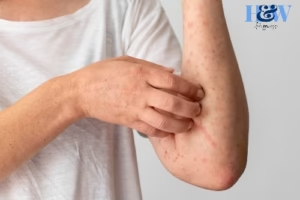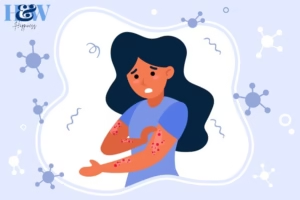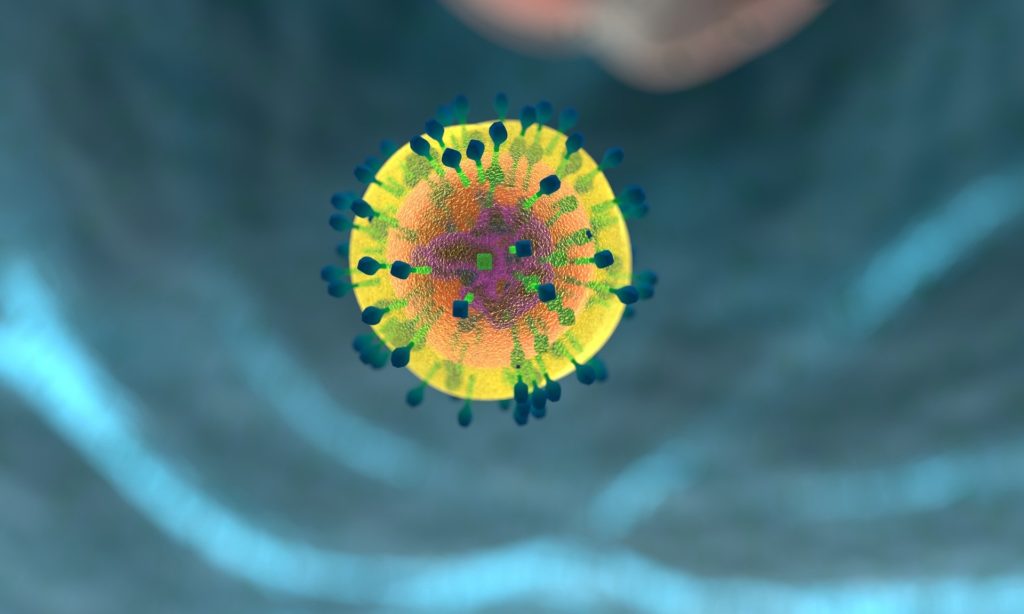What is Skin Allergy?
When the skin responds negatively to an allergen, it can cause a number of symptoms, including redness, swelling, itching, and blisters. This condition is known as a skin allergy. Because it incorrectly perceives some compounds as dangerous intruders and sets off an inflammatory reaction, the immune system is essential to this process. From little annoyance to severe symptoms that interfere with day-to-day activities, this response can take many forms.
Common Types of Skin Allergies:

1. Contact Dermatitis:
Dermatitis in contact Direct contact between an allergen and the skin can result in contact dermatitis. Skin that is red, itchy, and occasionally blistering is the hallmark of this disorder. There are mostly two kinds:
-
- Allergy contact dermatitis: This condition occurs when the skin responds to latex, metals (like nickel), perfumes, and preservatives. The response might not show up right away; in certain situations, symptoms might not show up for up to 48 hours.
- A chemical that physically irritates the skin allergy, such powerful detergents, acids, or solvents, can cause irritant contact dermatitis, which is different from allergic contact dermatitis. In most cases, the symptoms appear sooner than in allergic contact dermatitis.
2. Atopic Dermatitis (Eczema):
Chronic atopic dermatitis is frequently linked to a family history of hay fever, asthma, or allergies. Although the precise origin is unknown, a mix of immunological, environmental, and genetic variables are thought to be involved. Dry, scaly, and itchy skin patches are frequently the result of eczema, especially on the face, neck, hands, and legs. Although it is more common in youngsters, it may continue or resurface in adults.
3. Urticaria (Hives)
Frequently brought on by an allergic reaction to food, drugs, insect stings, or other allergens, hives are red, itchy welts that develop on the skin. Two categories exist:
-
Acute urticaria:
Skin allergy usually brought on by a particular trigger, such as food allergies, infections, or drugs, and lasting shorter than six weeks.
-
Chronic urticaria:
Lasts longer than six weeks and is frequently more difficult to diagnose; it can also happen without a recognized trigger.
4. Angioedema:
Similar to urticaria, this illness causes swelling around the eyes, mouth, neck, or extremities by penetrating deeper into the skin layers. If angioedema results in neck swelling that makes breathing difficult, it can be fatal. Although it may also be inherited, it is frequently linked to the same causes as hives.
5. Photosensitivity:
Sensitivity to light Certain drugs, fragrances, and other compounds can cause skin responses in certain people when they are exposed to sunlight. Skin that is photosensitive is red, puffy, and itchy; it frequently resembles a sunburn.
Causes and Triggers

The causes of skin allergies vary depending on the type, but common triggers include:
- Allergens: These are things that trigger an immunological reaction, such as dust mites, pollen, pet dander, certain foods, or drugs.
- Chemicals: Some skincare products, including detergents, soaps, and shampoos, include chemicals that might irritate skin or trigger an allergic reaction.
- Metals: Jewelry, garment fasteners, and other items that come into touch with the skin frequently contain nickel.
- Insect Stings or Bites: Reactions to insect stings or bites might vary from minor local discomfort to serious allergic reactions.
- Environmental Factors: Skin allergies may intensify in response to variations in temperature, humidity, or sunshine exposure.
Symptoms of Skin Allergies

Depending on the kind of allergy, skin allergies can present with a wide range of symptoms. Typical indicators include:
- Redness and Inflammation: The inflammatory reaction may cause the skin to appear flushed and puffy.
- Itching: One of the main symptoms is itching, which is frequently accompanied by a burning feeling.
- Dryness and Flaking: Dry patches that flake off are a common symptom of eczema.
- Blisters or Rashes: These might be fluid-filled blisters or elevated, red bumps.
- Swelling: Swelling around the eyes, lips, or extremities is possible, especially in situations like angioedema.
Diagnosis of Skin Allergies
A combination of a physical examination, medical history, and specialist testing is usually required to provide an accurate diagnosis of skin allergies. Typical diagnostic methods include the following:
- Patch testing: To see if there is a reaction, tiny quantities of possible allergens are put to the skin beneath patches. It aids in determining the causes of contact dermatitis.
- Skin Prick Test: A tiny needle is used to inject trace amounts of allergens into the skin. An allergy is indicated if a red, elevated lump develops.
- Blood tests: These can determine whether certain antibodies linked to allergic reactions are present.
Treatment Options for Skin Allergies
In order to treat skin allergies, the underlying cause must be addressed in addition to the symptoms. Among the strategies are:
1. Avoiding Triggers:
The best method of preventing symptoms is to recognize and stay away from allergens that trigger reactions. For instance, people with nickel allergies should stay away from jewelry made of this metal, and people who are sensitive to certain skincare products should choose hypoallergenic ones.
2. Medications:
- Antihistamines: Prescription or over-the-counter antihistamines help lessen inflammation and stop itching. Hives, angioedema, and other allergic reactions are frequently treated with them.
- Corticosteroids: These can be taken orally for more severe reactions or used locally as creams or ointments for localized irritation. Itching, redness, and edema can all be lessened with corticosteroids.
- Immunosuppressants: Drugs that inhibit the immune system, such cyclosporine, may be required for long-term ailments like eczema.
- Epinephrine (Adrenaline): An injection of epinephrine is necessary for severe allergic responses that result in anaphylaxis, a potentially fatal condition characterized by swelling of the throat and breathing difficulties. An epinephrine auto-injector is frequently carried by those with severe allergies in case of an emergency.
3. Topical Treatments:
- Moisturizers: Using moisturizers on a regular basis can help control dry skin disorders like eczema. They keep moisture from escaping the skin by creating a barrier of defense.
- Calamine Cooling Creams or Lotion: These helps relieve discomfort and itching.
- Topical Calcineurin Inhibitors: Without the negative effects of steroids, these non-steroidal creams, such as tacrolimus, help reduce inflammation in diseases like eczema.
- Phototherapy, or controlled exposure to UV light, may help alleviate the symptoms of persistent skin disorders like psoriasis or eczema that don’t improve with other therapies. To reduce the hazards of UV exposure, phototherapy is delivered under medical supervision.
4. Lifestyle and Home Remedies
- Colloidal oatmeal baths are a useful treatment for irritated and itchy skin.
- Cool Compresses: You can lessen swelling and itching by applying a cool, moist cloth.
- Humidifiers: In arid settings, using a humidifier can prevent the skin from getting overly dry.
Prevention Tips for Skin Allergies

Taking proactive measures to limit exposure to recognized allergens and irritants is essential to preventing skin allergies. The following are some tactics:
- Use products that are hypoallergenic: When choosing skincare, haircare, and home items, look for labels that say “hypoallergenic” or “fragrance-free.”
- Wear Protective Clothing: Gloves or long sleeves might help reduce skin exposure if contact dermatitis is an issue.
- Test new products with patches: Apply a tiny quantity to a less noticeable region of your skin to do a patch test before using a new skincare or cosmetic product to see whether a reaction happens.
- Steer clear of harsh chemicals: Steer clear of products that include alcohol or other drying agents, and go for mild soaps and detergents.
- Keep Up a Moisturizing Routine: Dryness and irritation brought on by diseases like eczema can be avoided by keeping your skin hydrated.
When to See a doctor?
While many skin allergies can be treated at home and with over-the-counter medications, other situations call for medical care. Consult a doctor if:
- Severe or worsening symptoms: Severe swelling, redness, or itching could be signs of a severe reaction.
- Breathing is difficult: This could indicate anaphylaxis, a potentially fatal situation.
- Chronic Conditions Do Not Respond to Treatment: Prescription drugs or specialized care may be required for conditions like eczema or chronic urticaria.
- Skin Infections Develop: Bacterial infections can result from persistent scratching that breaks the skin.
Conclusion
Although skin allergies can have a major negative influence on a person’s quality of life, they can be effectively managed with knowledge of their types, symptoms, causes, and available treatments. Accurate diagnosis is essential, and treatments—from topical medications and therapies to lifestyle changes—should be customized for each patient. People with skin allergies can lessen their symptoms and enhance their health by taking preventative actions and getting medical attention when they need it.


